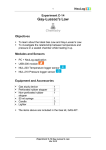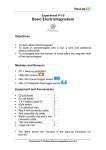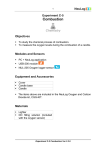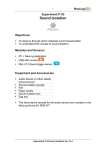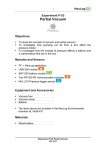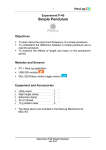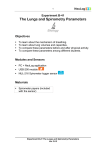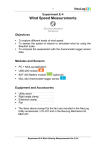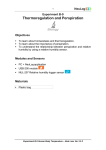Download Experiment E-2, Air Pressure and Altitude
Transcript
1 Experiment E-2 Air Pressure and Altitude Objectives To understand how air pressure changes with altitude. To measure altitude on different floors of a building using a barometer. Modules and Sensors PC + NeuLog application USB-200 module NUL-221 Barometer logger sensor BAT-200 Battery module Experiment E-2 Air Pressure and Altitude Ver 3.0.3 2 Introduction Air pressure is defined as the amount of force per unit area exerted against a surface by the weight of the air above that surface. When the number of air molecules above a surface is high, more molecules exert force on that surface, thus air pressure is also high. Air pressure reaches a maximum of about 1 ATM at sea level and decreases as altitude increases. Air pressure has an exponential decay. The pressure is cut by half every additional 5 km above the earth. Air pressure also changes with temperature since hotter air expands and has a lower weight. The barometer logger sensor can calculate altitude using the air pressure data. We will use this feature to measure the height of different floors of a building. Experiment E-2 Air Pressure and Altitude Ver 3.0.3 3 Procedure Experiment setup 1. This experiment is conducted in a building. If possible choose a building with at least three floors. Sensor setup 2. Connect the USB-200 module 3. Check that the barometer sensor USB-200 module. to the PC. is connected to the Note: The following application functions are explained in short. It is recommended to practice the NeuLog application functions (as described in the user manual) beforehand. 4. Run the NeuLog application and check that the barometer sensor is identified. Experiment E-2 Air Pressure and Altitude Ver 3.0.3 4 Settings 5. Click on the Off-line Experiment icon main icon bar. in the NeuLog 6. Click on the Sensor's Module box. 7. Click in the Range button. 8. Select the Altitude button to change the sensor's mode. 9. Set the: Experiment duration to 5 seconds Sampling rate to 60 per minute Experiment E-2 Air Pressure and Altitude Ver 3.0.3 5 Testing and measurements 10. Disconnect the sensor from the USB-200 module and connect it to a battery module. Make sure that the battery is properly charged. Sensor's Start/stop button 11. Go to the ground floor of the building and carefully place the sensor (connected to the battery module) on the floor. 12. Begin the measurement by pressing the sensor’s Start/stop button. The sensor's LED should turn on. Do not move the sensor during the measurement. Note: You should see that the sensor’s red LED is on during the measurement. When the LED turns off, it means the experiment time is over. The measured data will be stored in the sensor’s memory. 13. When the LED turns off, go to the first floor of the building and repeat the measurement. 14. Continue to measure the height of each floor. The sensor can store up to five measurements. If you are in a building with eight floors or more, measure every two floors. Experiment E-2 Air Pressure and Altitude Ver 3.0.3 6 15. At the end of the experiment, disconnect the sensor from the battery module. 16. Connect the sensor back to the USB-200 module. 17. Click on the Search Sensors icon Offline Experiment icon 18. and then click on the . Click on the Load Experiment icon . The menu shows a list of stored experiments in the sensor's memory (up to 5). 19. Choose the oldest experiment and click on the Load Experiments button. 20. The first graph should appear on the screen. Experiment E-2 Air Pressure and Altitude Ver 3.0.3 7 21. Your data should be similar to the following. Ground floor 22. Save your data. 23. Continue to upload the rest of the measurements and save them. First floor Experiment E-2 Air Pressure and Altitude Ver 3.0.3 8 Second floor Third floor 24. As altitude increases air pressure decreases. The height of each floor of the building was calculated by the sensor according to pressure data. Experiment E-2 Air Pressure and Altitude Ver 3.0.3 9 Challenge research 25. If you have a hill nearby or you are going on a trip, try to estimate the altitude when you are at the highest point. Measure the altitude at that point. Was your estimate correct? Summary questions 1. Write a few sentences about the Earth's atmosphere and its properties. 2. If air pressure at sea level is around 1 atm what will the air pressure be at 10 km above it. 3. Think about an experiment in which you can use the altitude feature of this sensor. 4. Explain how does pressure change with sea depth. Experiment E-2 Air Pressure and Altitude Ver 3.0.3









